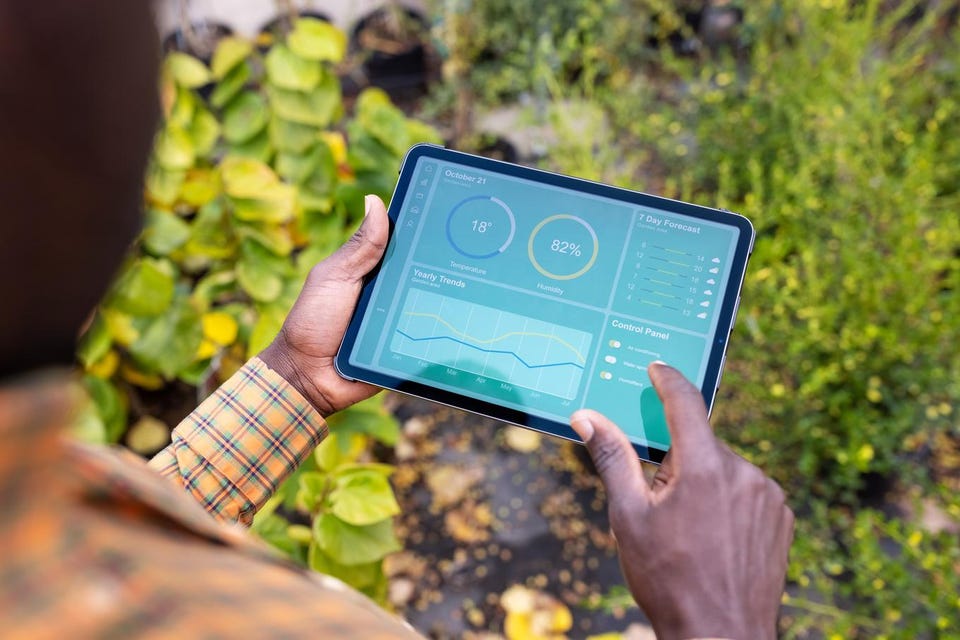Preparing For The Next Big Leap In Agricultural Innovation


The power of innovation makes an impressive display in the USDA’s survey of U.S. agricultural productivity. Since 1948, the land and labor used by farmers have fallen sharply—but the quantity of food they produce has more than doubled. Everywhere you look, it’s the same story: Farmers all over the world are doing more and more with less and less.
This incredible sustained growth, which has kept billions of people from starvation, isn’t simply baked into the business of being a farmer. For most of history, agricultural yields remained static. It took a series of groundbreaking innovations—mechanized harvesting, chemical fertilizers and, most recently, herbicide and pesticide-resistant crops—to enable farmers to keep pace with our planet’s booming population.
That’s where it gets tricky, though. We’ve already captured the gains from 20th-century agricultural breakthroughs—and in the case of chemical-resistant seeds, we’re now seeing diminishing returns that threaten to derail agricultural growth.
The first wave of resistant crops was a game-changer, but pests and weeds quickly developed chemical resistance. Seed companies went back to the drawing board and created new crops with resistance to a growing cocktail of chemicals, and the cycle repeated. Today, farmers are planting three-way resistant seeds, then blitzing their fields with multiple chemical treatments simply to fight weeds and pests to an expensive stalemate. The result: a degraded environment and—despite the industry’s plans for five-way resistant seeds—yields that are no higher than when Roundup Ready seeds were first introduced.
Time For A New Approach
The challenge is that chemical resistance is a one-way street. The more chemicals we spray on our crops, the more quickly pests and weeds evolve resistance—and the more chemicals farmers must apply to their fields to get the job done. Adding more and more chemicals to the mix, in the form of four-way or even five-way resistant crops, buys farmers a little time but, in the long run, only makes the problem worse.
Farmers and seed companies understand this, of course. That’s why we’re increasingly seeing a new kind of agricultural innovation—call it digital agriculture—that focuses not on expanding our chemical arsenal but on using new digital technologies to apply chemicals and other interventions far more sparingly and selectively.
Farmers have always been knowledge workers. From the Old Farmer’s Almanac to modern weather and market forecasting tools, it takes keen insights and real expertise to grow crops profitably and productively. Now, though, we’re seeing transformative new sources of agricultural intelligence, including digitized crops that can directly communicate the stressors they’re experiencing, from drought and nutrient shortages to fungal pathogens.
Combined with smart tractors and other precision agricultural tools, such breakthroughs allow farmers to tailor chemical interventions to the needs of individual plants. By listening to digitized crops, farmers can use chemicals more efficiently to drive far better results—lowering operating costs, boosting yields and preserving the environment upon which we all depend.
A Scalable Solution
Historically, farmers have sought efficiencies through chemistry, using fertilizers and pesticides to boost their yields. In the new era of digital agriculture, we’ll likely see a transition to driving efficiency with data, with farmers using deep insights into their crops—often on a plant-by-plant basis—to intelligently boost yields while using chemicals far more sparingly.
This represents a much-needed off-ramp for the ag sector as a whole. Instead of doubling down on specific genetic traits that provide chemical resistance and spraying more and more pesticides and herbicides onto our fields, Big Ag companies can incorporate a new generation of seed technology that paves the way for more intelligent, more precise and more sustainable farming methods.
As digital agriculture achieves critical mass, the ROI from such approaches is likely to become clearer. Unlike chemicals, data gets more powerful as it’s used more widely. In fact, the more we roll out digital tech, innovate new solutions and apply increasingly powerful analytics to ever-growing datasets, the better equipped we could become to develop the sustainable and profitable solutions farmers need in our fast-changing world.
No More Farming In The Dark
Today, farmers are standing at a crossroads. The existing agricultural model, which depends on pouring increasingly more chemicals onto our land, is a one-way street that could lead to disaster. But digital agriculture is a one-way street, too, because the more farmers gain data-driven visibility into the performance of their crops, the less willing they’ll be to go back to farming in the dark.
We still have a long way to go, of course. Based on traditional adoption curves for ag tech, it’s likely that although early adopters will embrace digital solutions over the next five years, these solutions will take a decade to gain mainstream acceptance. As my own company’s partnership with John Deere shows, though, it’s possible for trusted agricultural brands and biotech startups to work together to accelerate that transition and bring digital agriculture to market in transformative and rapidly scalable new ways.
With five-way resistant seeds currently slotted for rollout sometime around 2035, digital agriculture is already on track to beat the next generation of resistant seeds to market. That gives us an important window of opportunity to popularize new technologies that can allow farmers and seed makers to chart a more environmentally and economically sustainable path forward.
Change won’t happen overnight. But while crop yields are currently plateauing, the truth is that we’re on the cusp of a new wave of innovation—a kind of agricultural “enlightenment” in which farmers can use digital technologies that can help make smarter decisions and manage their land in more profitable and sustainable ways.
That might sound like a dream, but thanks to continuing breakthroughs in biotech and digital agriculture, it’s a dream that farmers now have the power to make a reality. To see the power of innovation in action, just watch this space.
